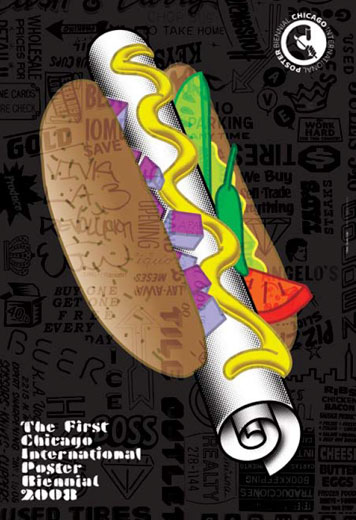
Chicago International Poster Biennial, poster design by Yann Legendre, 2008
Posters, so beloved by graphic designers everywhere, have never felt at home in the United States. The European poster tradition, from Toulouse-Lautrec to Cassandre to Muller-Brockmann to Matthies to Troxler, has given us the profession's defining icons. American posters, by contrast, have never enjoyed as confident or ubiquitous a street presence. Consider the memorable products of San Francisco's psychedelic era, for instance, or Art Chantry's output on behalf of the northwest music scene, great images but tactical moves designed for display on telephone poles or behind shop windows.
Yet even in the face of relentless competition from the even more ephemeral world of new media, posters continue to obsess us. And that obsession has a new home in the American heartland: the First Chicago International Poster Biennial. Design Observer is pleased to be an official sponsor. The deadline is May 27, so read on...
The Chicago International Poster Biennial is a not-for profit organization established to promote visual literacy, multiculturalism, and international cooperation through the poster work of artists from around the world.
Contemporary posters published within the last two years are eligible for the competition and may be submitted by any poster designer in the world with no entry fee. Physical entries must be received in Chicago no later than May 27, 2008. Entry guidelines and submission instructions are here.
A world-renowned jury of 11 poster designers will select 100 winners. Three artists will receive medals, and one will be awarded the grand prize in the form of a gold medal.
John Massey, jury chair, will be leading an impressive group of international jurors that includes Michel Bouvet of France, Shigeo Fukuda of Japan, Yossi Lemel of Israel, Alfred Halasa of Canada, German Montalvo of Mexico, Yann Legendre and Jay Ryan of Chicago, and Luba Lukova, Lanny Sommese and Martin Venezky, also of the United States. More about the jury is here.
Concurrent with judging of the competition, a gala opening of the jury exhibition will be held June 7 in Mies Van der Rohe's landmark Crown Hall at Chicago's Illinois Institute of Technology . A larger exhibition of the winning entries will be mounted in Chicago in the fall of 2008.
The International Council of Graphic Design Associations (icograda) has endorsed this first Chicago poster competition. While icograda endorses many such open competitions around the world, this will be the first event of its kind held in the United States.
Official sponsors and partners include Design Observer, Society of Typographic Arts, Graphic Arts Studio, Handler Thayer & Duggan LLC, JCDecaux, Mohawk Fine Papers, STEP Inside Design Magazine, Tanagram Partners and World Business Chicago.


Comments [14]
05.07.08
12:36
"Only printed posters by offset methods or silkscreen prints will be accepted."
Too bad the rules are holding to these qualifications. Many great underground posters don't even make it to these production methods or at these sizes, as smaller venues and promoters can't afford to produce their advertisements by these methods.
I'm thinking of many great grunge and punk and hardcore and indie rock posters over the years that have been produced on 8.5" x 11" or 11" x 17" sheets passed through a photocopier.
05.07.08
01:02
Given those specs, the rolled up print in the hot dog bun on the show poster would be too small for submission.
05.07.08
05:31
Also, by requiring a TIFF are they ruling out posters that weren't designed digitally or would photographs suffice?
05.08.08
03:18
What about the great WWI and WWII recruiting and cautionary posters? And movie posters? I think you're not going back far enough.
05.08.08
04:41
An important issue to consider is that the Chicago Biennial is attempting to bring international poster design out into the broad daylight of public scrutiny. The winners will not be exhibited in a museum but outside, in a large public park. So we are trying to take a step beyond celebrating underground poster "art" for a small audience and, instead, would like posters to be seen as a viable, available, and powerful form of communication art.
Concerning the history of poster design in the USA, it is certainly true that great posters have been designed here in the past and, at times, in the present. But it is impossible to argue the reality that while contemporary poster design is alive and well throughout Europe, Asia, and South America, posters are a form of communication that thrives in the US mostly in vintage poster shops and museum archives... or hawking iPods on billboards.
05.10.08
10:01
Photographs or scans of high quality submitted as a digital file are allowed for posters not created on a computer.
05.10.08
10:06
It's just a very myopic viewpoint, especially at a time when the poster medium is both in a renaissance and on the precipice of irrelevance (they win all the awards and everyone loves them but not many people actually see them applied in the real world).
By excluding certain sizes and low quantity but legitimate methods of reproduction (giclée and archival ink jet) I feel the decision was an overly safe one, not one that aimed at really looking at the future of the poster and celebrating powerful communication in all it's poster forms.
05.12.08
11:10
What is myopic more than the design profession's happy acceptance of competitions that are singularly focused on selling annuals to the design community? You're right in that "not many people actually see them applied in the real world." That's the problem. True relevance will return only with hard work--the kind of work that forces us to speak strongly and publicly about the value of ideas and artistry, not about methods or technology. A plea for posters has to start somewhere, and this initiative to bring a world view of what posters can be is a good one. I prefer to focus on this event's potential, not brush value aside and jump straight to its flaws. The rules can easily be changed from one competition to the next. As I mentioned before, the jury is willing to make concessions based on sound reasoning, but that reasoning will not be found justified if the argument goes no further than the fact that there was no budget to actually print the poster. I'm sure designers with these concerns will always be able to find a competition willing to accept their entries.
05.12.08
01:16
05.12.08
01:51
05.12.08
03:07
05.13.08
11:44
05.13.08
12:08
Yes, letterpress posters will be accepted into the competition. Thanks for asking.
05.13.08
03:23